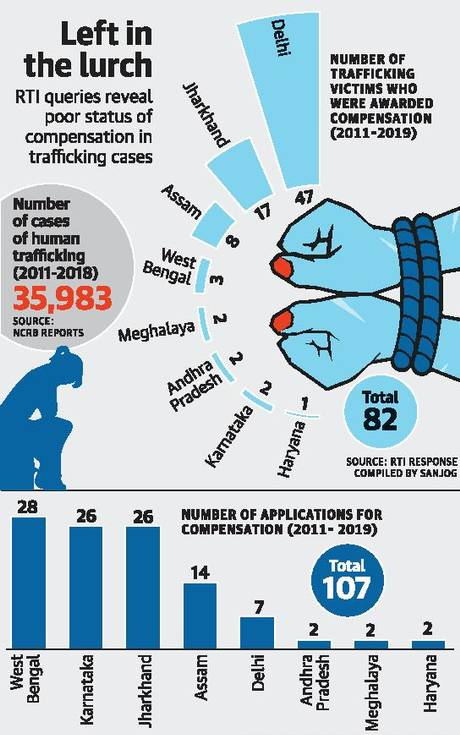Poor Compensation Rate for Trafficking Survivors | 10 Feb 2020
Why in News
Based on the data of the NCRB, a non-profit organisation released a report on compensation awarded to survivors of trafficking the country, which highlighted the poor status of compensation awarded during 2011- 2019.
- NCRB reports put the total number of cases of human trafficking at 35,983, but only 82 (0.2%) victims were awarded compensation.
Key Points
- The report titled ‘UNCOMPENSATE VICTIMS’ was released by Sanjog, a technical resource organisation that works to combat trafficking and gender-based violence.
- Following the national outrage over the Nirbhaya gang-rape case (2012), the government had announced ₹1,000 crore fund to be used to combat sexual violence against persons – children or adults.
- The amount of compensation to victims of trafficking varied from State to State, hence the Supreme Court had directed the National Legal Services Authority (NALSA) to frame a standardised victim compensation scheme.
- The study also reflects the number of trafficking survivors who applied for the victim compensation scheme to their respective legal services authority.
- While 107 individuals applied under the scheme, in 102 cases between 2011 and 2019, courts directed the authorities to release compensation.
Reasons Behind the Low Rate of Compensation
- Lack of awareness
- A lack of information provided to survivors on victim compensation.
- Low investment on part of legal aid
- Role of Legal Services Authorities: The study suggests grave inconsistencies on the part of legal services authorities, which have provided the data.
- There is a lack of initiative on the part of legal services authorities.
- Manipur’s 2019 victim compensation scheme does not even have an entry in the schedule corresponding to human trafficking.
- Survivors were able to apply only when they were informed and a private lawyer was involved in assisting them in filing the application for victim compensation.
- Multiple Agencies: From their rescue till rehabilitation, the survivors are in touch with multiple agencies but none of them takes any steps to help them get compensation.
- District Legal Service Authority(DLSA) and State Legal Services Authority (SLSA)’s response to the claims has been slow, and they hold the survivors’ claims with suspicion – often putting the burden of proof on the survivors themselves.
Central Victim Compensation Fund scheme
- The Section 357-A of Code of Criminal Procedure (CrPC) has provisions to compensate victims who suffered because of a crime.
- Section 357A: Every State Government in coordination with the Central Government shall prepare a scheme for providing funds for the purpose of compensation to the victim of crime.
- The government introduced the Central Victim Compensation Fund (CVCF) scheme to enable support to victims of rape, acid attacks, human trafficking and women killed or injured in the cross border firing.
- Compensation for Civilian victims of cross border firing, shelling or IED explosion, terrorism and Maoist violence
- It is also known as the Victim Compensation Scheme.
- So far 24 states and 7 UTs have formulated the Victim Compensation Scheme.
Nirbhaya Fund
- The Nirbhaya Fund Framework provides for a non-lapsable corpus fund for the safety and security of women.
- It is administered by the Department of Economic Affairs (DEA) of the Ministry of Finance.
- It can be utilized for projects and initiatives related to women safety.
- Nirbhaya fund is being used in the Central Victim Compensation Fund (CVCF).
